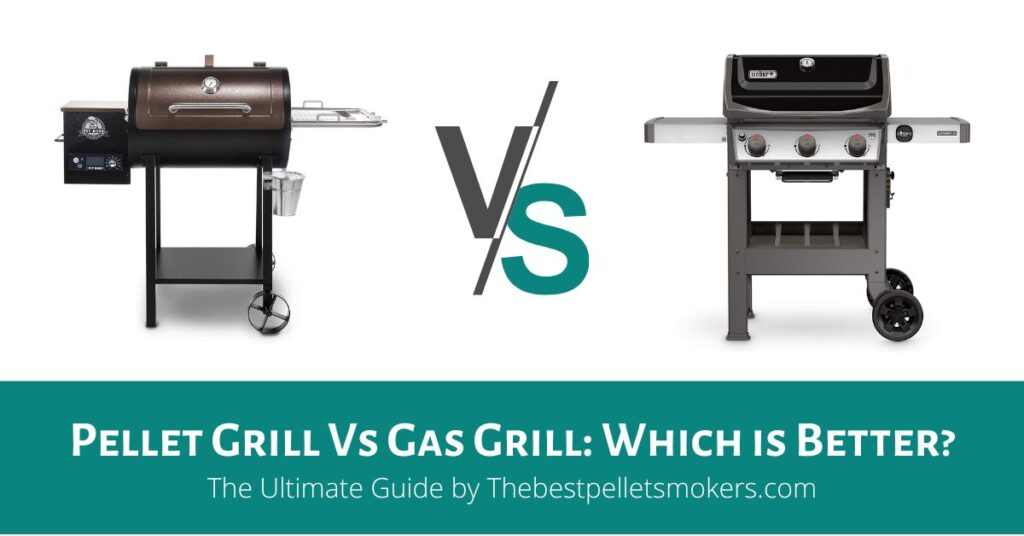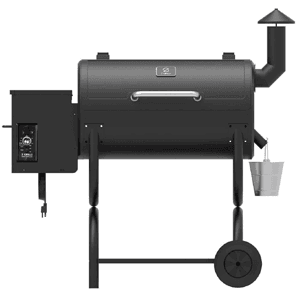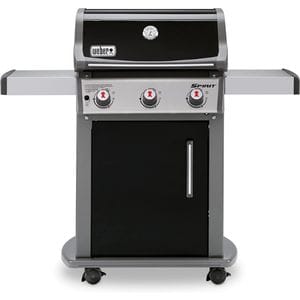Grilling is one of America’s favorite pastimes, for a good reason. There’s nothing quite like the smell of grilled food or the taste of a juicy hamburger or steak fresh off the grill.
It’s a time-honored tradition that has been passed down through generations. And while the methods may have changed slightly over the years, the basics have remained the same. But, as with everything else in life, some pretty significant advances have been made in grilling technology – specifically when it comes to pellet grills and gas grills.

So which one is better? That’s what we’re going to explore in this blog post. We’ll look at the pros and cons of both types of grills and some tips on choosing the right one for you. Stay tuned – it’s time to get grilling!
Pellet Grill Overview

A pellet grill is a type of grill that uses compressed wood pellets as fuel. These pellets are made from sawdust or other wood waste, and they’re a popular option for grilling because they’re environmentally friendly and easy to use.
- To start a fire in a pellet grill, you’ll need to add pellets to the hopper located at the bottom of the grill.
- Then, use the igniter to light the pellets and adjust the vents to control the amount of air that flows through the grill. The pellets will smolder rather than burn, creating smoke that adds flavor to your food.
- When smoking, you’ll want to maintain a low temperature, so the food doesn’t cook too quickly.
- For grilling, you’ll want to increase the temperature so that the food becomes crispy on the outside while remaining juicy on the inside.
Pellet grills are a great option for those who want to enjoy Smokey flavor without dealing with charcoal or propane. They’re also easy to use, making them perfect for beginner grillers. So if you’re looking for an eco-friendly and easy-to-use grill, a pellet grill is a great option.
Gas Grill Overview

A gas grill is a type of grill that uses gases such as propane as fuel. These grills typically have one or more burners that heat the grill to a cooking temperature. The heat is then transferred to the food through radiant heat, convection, or a combination of both.
Gas grills are available in various sizes, from small portable grills to large ones suitable for outdoor kitchens. Most gas grills have a side shelf where condiments and other items can be placed, and some also have storage areas for the propane tank or other grilling tools.
When choosing a gas grill, it is essential to consider the size of the unit, the number of burners, the type of ignition system, and the features offered. Gas grills are a great way to cook food outdoors and can be used year-round in most climates.
Some things to keep in mind when using a gas grill.
- It includes safety precautions, preheating the grill properly, ensuring the food is cooked evenly, and using the correct type of gas for the grill.
- Gas grills should be used in well-ventilated areas, as fumes from the gases can be harmful if inhaled.
- It is also essential to follow the manufacturer’s instructions carefully when using a gas grill. Improper use can result in fires or explosions.
A gas grill can last many years and provide many enjoyable outdoor cooking experiences with proper care and maintenance.
Pellet Grill Vs Gas Grill: The Differences
| Category | Our Choice |
| Ease of use | Gas grill |
| Temperature control | Pellet grill |
| Fancy features | Pellet grill |
| Initial cost | Personal preferences and budget |
| Run time | Gas grill |
Ease Of Use
If you’re looking for a hassle-free grilling experience, a gas grill is the way to go. Just turn on the gas, push a button, and you’re ready to cook. Pellet grills require a bit more effort to get started, but many people feel the extra steps are worth it for the flavor they impart to food.
Pellet grills use wood pellets as fuel, so you’ll need to load them into the hopper and light the fire before cooking. This gives you more control over the flavor of your food, as different types of wood will impart different flavors. For example, mesquite pellets will add a smoky flavor, while hickory pellets will be milder.
Temperature Control And Range
One of the main differences between pellet and gas grills is temperature control. Pellet grills typically have more precise temperature control, making them ideal for slow cooking or smoking. Gas grills, on the other hand, tend to have a wider temperature range, making them better suited for searing or grilling at high heat.
Another difference between pellet and gas grills is the range. Pellet grills can reach temperatures as high as 500 degrees Fahrenheit, making them ideal for searing meat. Gas grills, on the other hand, top out at about 450 degrees Fahrenheit. This makes them better suited for slow cooking or smoking.
Fancy Features
Gas grills come with built-in rotisseries for slow-roasting meats, and side burners for simmering sauces or sautéing veggies. Gas grills don’t come with automated temperature control features, while pellet grills do. This means that you’ll have to keep an eye on the grill to make sure that the temperature doesn’t get too high or low. Pellet grills also have WiFi and Bluetooth capability, as well as an LCD screen.
Initial Cost
Another big difference is in the initial cost. Almost every big box retailer in the world sells gas grills for a reasonable price, and the top ones can cost well over a thousand dollars. If you’re thrifty, you might be able to find a used unit for a fair price in your local ads. On the other hand, pellet grills are often significantly more expensive at first.
Even the less expensive units you get at your neighborhood big box retailer will cost you more than $500, and that’s for a less robust, smaller unit. But before you write off pellet grills as being too expensive, it’s important to understand that they offer some significant advantages over gas grills, particularly in terms of convenience and safety.
Run Time (Before Refueling)
Anytime you’re grilling for a group, you want a grill that will last long enough to get the job done. If you’re cooking for a large crowd, a gas grill is likely your best bet—you can keep it going as long as you have propane. Pellet grills also run on fuel, but they use wood pellets instead of propane. A 20-pound bag of pellets will last you about 4 to 6 hours of cooking time, so if you’re looking to do some serious grilling, you might need to stock up on a few bags.
Summing Up
So, which type of grill should you get? Ultimately, the decision comes down to personal preference.
Buy a gas grill if;
- If you are on a tight budget, then a gas grill might be the way to go. They tend to be less expensive than pellet grills, so you won’t have to spend as much money upfront.
- If you just want to cook the basics, like burgers and hot dogs, then a gas grill might be all you need.
- They also tend to heat up faster than pellet grills, so if you’re looking for speedy cooking times, a gas grill is a way to go.
Buy a pellet grill if;
- If you care about flavor, then a pellet grill is probably a better option. Pellet grills use wood pellets as fuel, which gives your food a unique smoky flavor.
- Pellet grills also tend to be more versatile than gas grills since you can use them for smoking as well as grilling.
- Pellet grills are also better for searing meat since they can reach high temperatures quickly.
So ultimately, the decision between a pellet grill and a gas grill comes down to your personal preferences. Consider what’s important to you in a grill and make your decision based on that.
We hope this article has helped you make an informed decision about which type of grill is right for you. Thanks for reading!